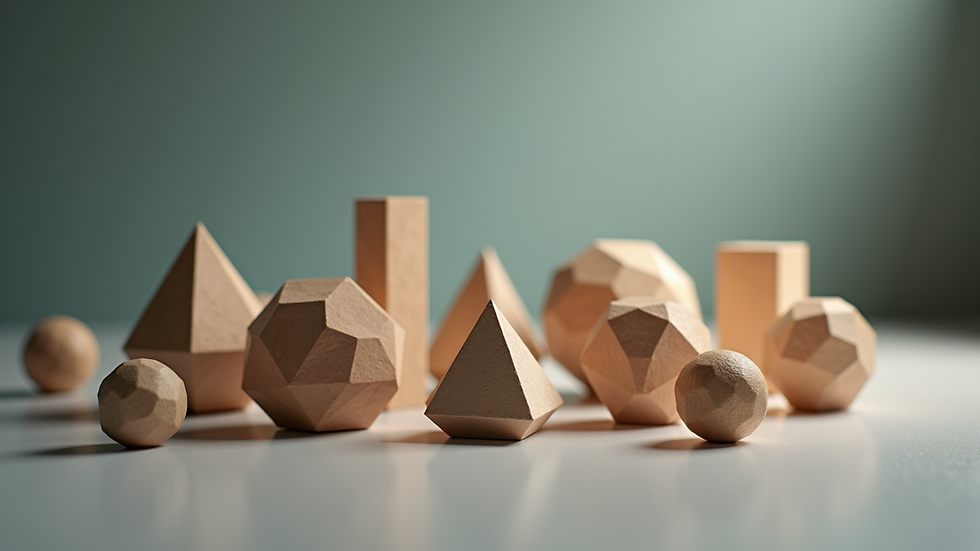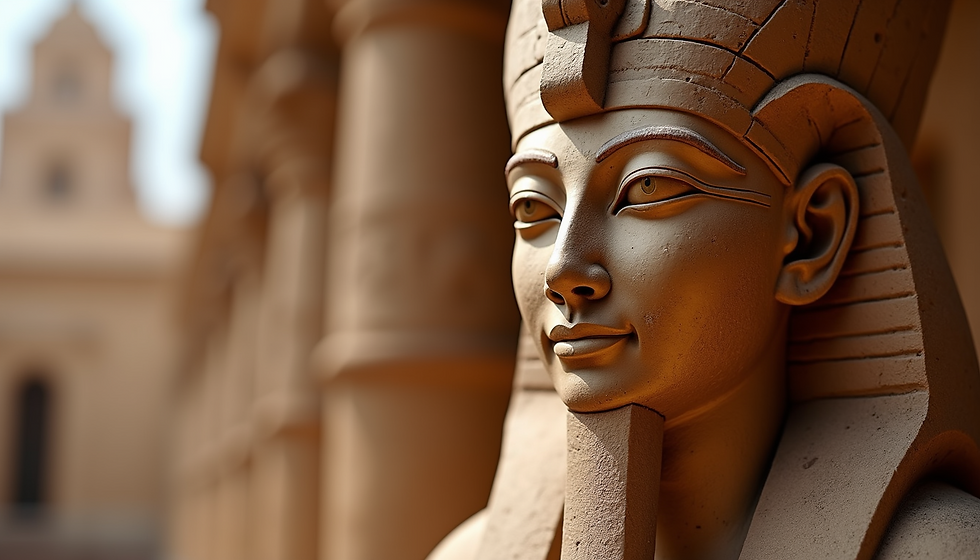The Hidden Secrets of Platonic Solids and Their Spiritual Significance
- Claire Leeks
- Jul 13
- 5 min read
Have you ever noticed how certain shapes and patterns seem to resonate deeply with your intuition? Geometry is more than mere math; it's a language of the universe. Among its fascinating figures, Platonic solids stand out as profound symbols that connect both our physical reality and our spiritual selves. These five unique polyhedra—the tetrahedron, hexahedron, octahedron, dodecahedron, and icosahedron—have been used throughout history in spiritual practices. They are tools for meditation, energy healing, and self-discovery. In this blog post, we will uncover how Platonic solids offer hidden secrets and meaningful insights into our spiritual journeys.
What are Platonic Solids?
Platonic solids are three-dimensional shapes composed of regular polygonal faces. In simpler terms, every face is the same, and all the corners, or vertices, are identical. The five recognized Platonic solids include:
Tetrahedron: A pyramid with four triangular faces. This shape is often seen in nature, such as in the molecular structure of methane, which contains a carbon atom bonded to four hydrogen atoms.
Hexahedron: Commonly known as a cube, this solid has six square faces. The perfect symmetry of a cube can be found in everyday objects like dice, which add an element of chance to games.
Octahedron: This solid features eight triangular faces, resembling two pyramids joined at their bases. An octahedral crystal structure is found in minerals like fluorite.
Dodecahedron: Comprising twelve pentagonal faces, this shape is rare in nature. Its complex design can be seen in certain viruses, adding to its mystical appeal.
Icosahedron: With twenty triangular faces, the icosahedron is closely related to the structure of the common cold virus, making it a fascinating study in both geometry and biology.
Each of these solids has unique properties and qualities that resonate with both mathematical concepts and sacred geometry.
The Spiritual Significance of Platonic Solids
The allure of Platonic solids extends beyond geometry; they are fundamentally woven into spiritual practices and metaphysical beliefs. Historically, these shapes have acted as conduits, connecting our material existence with higher spiritual truths. They play key roles in personal growth and enlightenment.
Each Platonic solid aligns with one of the five classical elements, presenting a unique energy and purpose:
Tetrahedron (Fire): Represents transformation and passion. Think of how fire ignites change in nature. For example, in a personal development journey, the tetrahedron can inspire you to break free from stagnation.
Hexahedron (Earth): Symbolizes stability and grounding. When life feels chaotic, envisioning a hexahedron can help you find your center, similar to practicing mindfulness in nature.
Octahedron (Air): Embodies clarity and intellect. It encourages fresh ideas and open-mindedness. Picture a brainstorming session that flourishes with creativity when you channel octahedral energy.
Dodecahedron (Ether/Spirit): Represents the universe and interconnectedness. It invites you to explore spiritual dimensions beyond the physical. This solid can inspire meditation sessions that deepen your understanding of the cosmos.
Icosahedron (Water): Symbolizes fluidity and emotional depth. Just as water adapts to its surroundings, the icosahedron nurtures emotional resilience during tough times, guiding you to flow with life's challenges.
Engaging with Platonic Solids in Spiritual Practices
Bringing Platonic solids into your spiritual practices can enhance your connections with the universe and enrich your meditation experiences. Here are practical methods to incorporate them into your life:
Meditation with Platonic Solids
Focusing on a specific Platonic solid during meditation can help you access its unique energy. For instance, visualizing a tetrahedron could increase your creativity, while imagining a dodecahedron might enhance your understanding of the greater universe.
Energy Healing
Many practitioners use the geometric shapes of Platonic solids to channel healing energies. For example, the symmetrical properties of these shapes can resonate with the human body's energy centers, or chakras, promoting physical and emotional balance. Research has shown that sound frequencies, often used in energy healing, can harmonize well with these geometric forms, enhancing their effects.
Creating Sacred Spaces
You can incorporate Platonic solids into your sacred spaces or altars. Adding crystal structures or images of these shapes serves as a reminder of the balance and harmony of the universe. Consider placing a crystal tetrahedron in a meditation space to inspire passion and transformation.

Symbolism of Each Platonic Solid
Tetrahedron (Fire)
The tetrahedron is a powerful symbol of ambition and transformation. Picture how it inspires people to pursue their passions, whether launching a new project or enhancing personal growth through self-improvement.
Hexahedron (Earth)
Stable and solid, the hexahedron represents the grounding force of Earth. It can remind us to connect with nature, perhaps by spending time outdoors or gardening, grounding ourselves in the present moment.
Octahedron (Air)
The octahedron encourages clear thinking and the pursuit of knowledge. It invites contemplation, fostering open-mindedness in conversations, adding perspective to our understanding of different viewpoints.
Dodecahedron (Ether/Spirit)
The dodecahedron stimulates spiritual exploration and self-discovery. Engaging with this solid invites seekers to look beyond the mundane, encouraging regular practice of gratitude or reflection to elevate consciousness.
Icosahedron (Water)
Fluid and adaptable, the icosahedron embodies emotional awareness and intuition. It nudges us to acknowledge and embrace our feelings, offering a reminder to stay in tune with our desires, especially during turbulent times.
The Connection between Geometry and Spirituality
Sacred geometry, which includes Platonic solids, serves as a key to understanding spiritual truths. Ancient civilizations, such as the Greeks and Egyptians, recognized the significance of these shapes. They integrated them into their philosophies, understanding their influence on the natural world.
Even today, these shapes inspire individuals on their spiritual journeys. By incorporating Platonic solids into your meditative practices and reflecting on their symbolism, you can align your energies and foster a deeper connection with the cosmos.

Practical Tips for Incorporating Platonic Solids into Daily Life
Visualization: Set aside a few minutes each day to visualize a specific Platonic solid. Focus on its characteristics and the energy it represents, such as grounding or inspiration.
Artwork: Surround yourself with art that features Platonic solids. This can serve as a constant reminder of their spiritual significance and integrate their energies into your daily environment.
Journaling: Reflect on how each solid resonates with your personal experiences. Document moments where you connected deeply with each element they represent, fostering a deeper understanding of your path.
Use in Rituals: Incorporate these shapes into your rituals or intention-setting practices. Use them as focal points to empower your intentions, whether in goal setting or manifesting desires.
Closing Thoughts
The secrets of Platonic solids create a rich tapestry of symbolism and meaning that transcends time. These five shapes not only enhance our understanding of our material world but also provide deep spiritual insights and pathways to the cosmos.
Integrating Platonic solids into your life can promote growth, offer clarity, and cultivate a profound relationship with the universe. Through meditation, energy healing, or designing your sacred spaces, these awe-inspiring shapes will undoubtedly enhance your spiritual journey, unlocking new aspects of your existence.









Comments